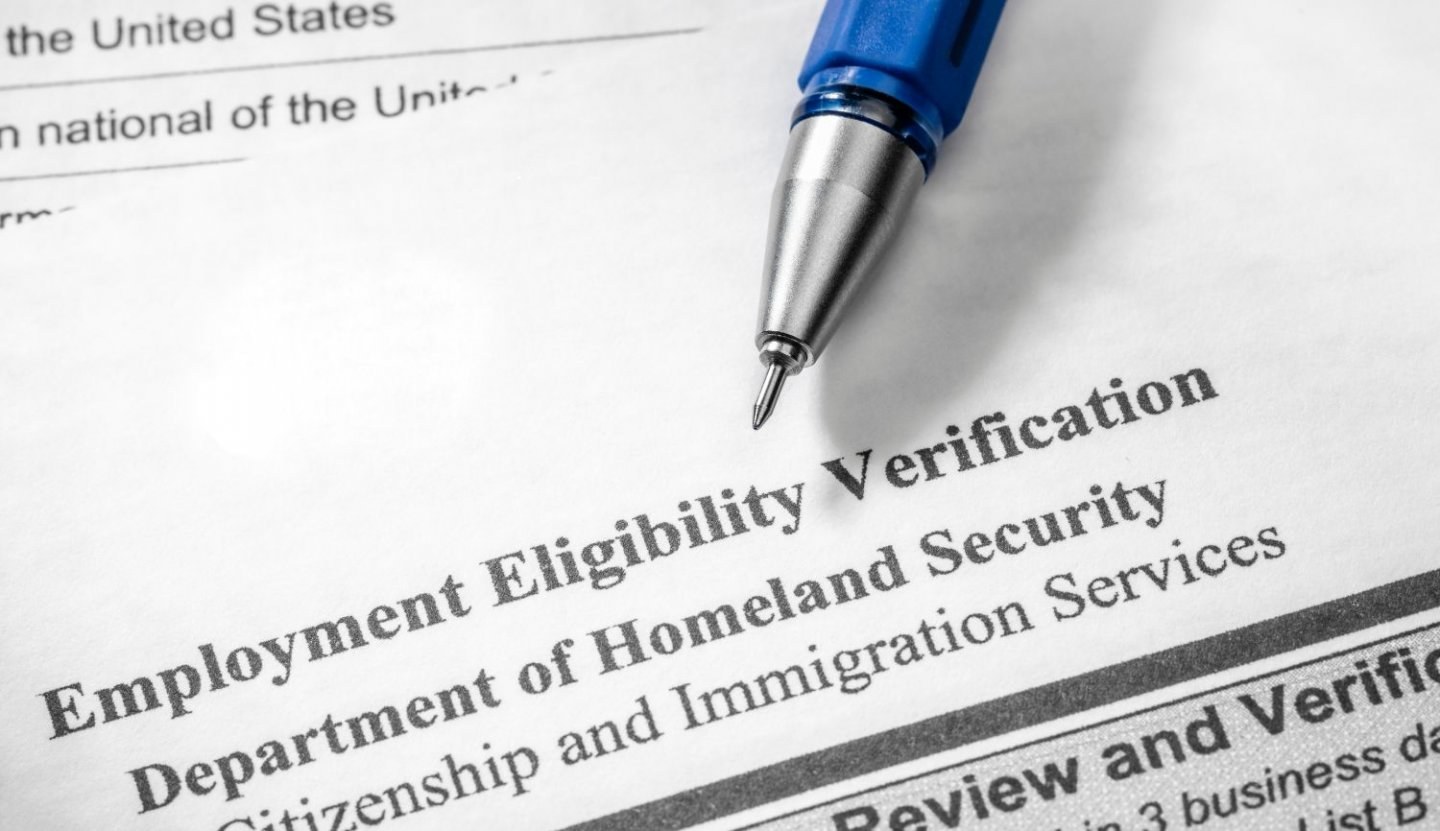
- HR Speak
- HR Compliance
- The Importance of I-9 Compliance: What Employers Need to Know
In this article, we'll explore:
Stay ahead with expert insights.
Payroll setup, benefits enrollment, and workplace training are all vital steps in creating a smooth employee onboarding experience. Equally important—and legally required—is completing Form I-9, which verifies that employees are authorized to work in the United States and ensures employers comply with federal hiring laws.
When done properly, Form I-9 compliance protects your business from government penalties, supports a legal workforce, and creates a strong foundation of trust with employees. But when mismanaged, even minor errors—such as missing forms or missed deadlines—can result in costly audits, I-9 compliance fines, and even reputational harm.
In this article, we’ll explain the purpose of Form I-9, outline employer responsibilities, and provide best practices to help you protect your workforce and reduce the risk of noncompliance.

What is Form I-9 and what is its purpose?
The Immigration Reform and Control Act of 1986 established Form I-9, Employment Eligibility Verification, as a requirement for all U.S. employers. The purpose of Form I-9 is to verify the identity of every new hire and confirm that they are authorized to work in the United States—whether as a U.S. citizen, a lawful permanent resident, or another worker with valid documentation.
Unlike E-Verify, an electronic verification system that is voluntary for most employers but required under some state laws and federal contracts, Form I-9 compliance is a federal requirement for all U.S. employers.
In addition to verifying the identity and employment authorization of your employees, I-9 compliance requires properly completing, storing, and retaining I-9 forms and related documents in accordance with federal law.
Understanding Employer Responsibilities and Timelines
Employers and employees share responsibility for completing Form I-9 correctly and within required timelines. For businesses, understanding these requirements is critical—not only for Form I-9 compliance but also to avoid fines and prevent delays in the onboarding process.
Below are the core requirements every employer should know to ensure the proper completion of I-9 forms:
- Section 1 (Employee): Employees must complete and sign Section 1 on or before their first day of work. In this section, they provide basic personal information and attest to their citizenship or immigration status.
- Section 2 (Employer): Employers must provide the employee with the official Form I-9 instructions and the Lists of Acceptable Documents. You are then required to review the employee’s documents and complete Section 2 within three business days of the employee’s start date. If employment lasts fewer than three days, Section 2 must be completed by the first day.
- Document review: Employers (or authorized representatives) must review original, unexpired documents that establish both identity and employment authorization. Employees may present:
- One document from List A (such as a U.S. Passport, Green Card, or Employment Authorization Document), or
- One document from List B (identity, e.g., driver’s license) and one from List C (work authorization card, e.g., Social Security card or birth certificate).
Employers must ensure the documents appear genuine and reasonably relate to the person presenting them. Photocopies or expired documents cannot be accepted.
Virtual Verification of I-9 Compliance Forms
E-Verify is a federal web-based system that compares the information from Form I-9 with government records to confirm employment eligibility. While E-Verify participation is voluntary for most employers, some states and federal contractors are required to use it.
As of August 2023, E-Verify employers in good standing* may take advantage of an alternative virtual verification process. Instead of reviewing documents in person, employers can inspect them over a live video call.
To remain compliant, employers must:
- Retain copies of the documents reviewed, and
- Check the “alternative procedure” box on Form I-9.
When followed correctly, this option can reduce administrative burden, provide extra assurance against hiring unauthorized workers, and simplify reverification. But it’s critical that employers adhere strictly to E-Verify procedures and maintain consistent recordkeeping.
*An E-Verify employer in good standing is one that is actively enrolled in the program, consistently uses E-Verify to confirm work eligibility for new hires, and complies with all program rules and requirements.
Applying Procedures Consistently
Employers must apply I-9 procedures uniformly to maintain compliance and avoid discriminatory practices. For example, you cannot request more or different documents than those listed in the Form I-9 instructions, demand a specific document from an employee, reject documents that “reasonably appear to be genuine”, or treat employees differently based on citizenship status or national origin.
How to Retain and Securely Store I-9 Records
Consistency in how you verify employees should also carry over to how you store and retain I-9 forms. Compliance doesn’t stop once the paperwork is complete—you must retain each Form I-9 for three years after the hire date or one year after termination, whichever is later.
Acceptable storage methods include paper files, microfilm, or electronic systems, but you must ensure the records are secure, accessible for inspection, and protected from data breaches. If you choose to keep document copies (which is optional, unless using the remote verification procedure), apply this practice consistently for all employees.
Electronic I-9 systems can help. By simplifying storage, creating clear audit trails, and providing safeguards such as encryption and role-based access controls, you can protect sensitive employee data and reduce the risk of noncompliance. For example, a digital system can send automatic reminders before retention deadlines, helping you stay organized and avoid costly oversights.
Concerned about data security?
Explore how to strengthen remote workforce cybersecurity in today's digital workplace.
When to Reverify and How to Manage Rehires
Employers must reverify employment authorization when an employee’s work authorization expires. This is done using Supplement B (formerly Section 3) of Form I-9.
Employers should not reverify U.S. citizens, permanent residents with valid green cards, or employees when List B documents (such as driver’s licenses) expire. In these cases, no action is required because work authorization has not changed. Instead, maintain the original I-9 and follow normal retention practices. Ensure only employees with expiring employment authorization are scheduled for timely reverification. The I-9 remains valid as long as the individual continues working and their underlying employment authorization does not expire.
For rehires within three years of the original hire date, employers can either complete a new Form I-9 or update Supplement B, depending on the situation.
What to Expect During Audits and Government Inspections
Government agencies—including the Department of Homeland Security, Department of Labor, and Department of Justice—may inspect I-9 records to confirm that your business is following federal hiring laws. These audits are designed to ensure workforce compliance and protect employee rights.
The most common scenario is receiving a Notice of Inspection (NOI) from Immigration and Customs Enforcement (ICE) for a Form I-9 inspection. An NOI is typically issued when ICE conducts a compliance review of your company’s hiring practices. These reviews may be initiated randomly in response to industrywide enforcement priorities or triggered by a specific tip. Employers usually have three business days to provide requested I-9 forms and related records, such as payroll and business registration documents.
In some cases, ICE agents may arrive unannounced for a worksite enforcement action. While less common, these actions are more likely to occur in industries with higher rates of unauthorized employment. For most employers, however, audits occur through the NOI process rather than on-site enforcement.
Beyond ICE, federal agencies may audit businesses as part of broader efforts to ensure workforce compliance and protect employee rights. Because audits can occur with limited notice, it’s important that you maintain organized, accurate, and easily accessible records.
How Internal Reviews Help You Fix Issues Before They Cost You
Conducting periodic internal Form I-9 compliance reviews helps you identify missing forms or errors before regulators do and demonstrates good faith if your business is ever inspected. In addition, regular reviews reduce the risk of fines, improve record accuracy, and give HR teams confidence that documentation is in order.
When correcting errors, follow official guidance: cross out the incorrect information, enter the correct data, and initial and date the correction. If the error is in Section 1, the employee must make the correction. For electronic systems, be sure audit logs track who made the change and when.
Keeping a clear audit trail is essential, both to maintain compliance and to show inspectors that your business takes its responsibilities seriously.
The Penalties for I-9 Noncompliance
I-9 noncompliance can carry steep financial consequences, even for small businesses—and minor errors across multiple forms can add up to significant fines. Penalties are calculated based on the percentage of violations and five statutory factors:
- Company size
- Good faith efforts
- Seriousness of the violation
- Presence of unauthorized workers
- History of violations
Below is a breakdown of the penalties (as of 2025):
- Paperwork violations: $288 to $2,861 per violation
- Knowingly hiring or continuing to employ unauthorized workers:
- First offense: $716–$5,724 per worker
- Second offense: $5,724–$14,308 per worker
- Third or subsequent offense: $8,586–$28,619 per worker
The Nonfinancial Costs of I-9 Noncompliance
Beyond monetary fines, failure to adhere to I-9 compliance requirements can lead to reputational damage, strained employee trust, and increased scrutiny from regulators. Your business may also experience disruption during government audits, loss of productivity, and negative media coverage—issues that can harm recruiting and retention.

Common Mistakes That Lead to Form I-9 Compliance Violations
Most I-9 compliance issues don’t stem from deliberate violations. They are often a result of small, easy-to-miss errors. These administrative slip-ups may seem minor but can add up to serious fines if left unchecked.
Here are frequent I-9 compliance mistakes that can lead to violations:
- Employee fails to check a status box or selects more than one
- Employee does not sign or date the I-9
- Employer fails to complete Section 2 within three business days
- Employer accepts incorrect or expired documents during review
- Employer omits hire dates, addresses, or certification details
- Employer applies inconsistent retention practices for document copies
Best Practices for Strengthening I-9 Compliance
To reduce the risk of I-9 compliance violations and improve efficiency, it’s essential to adopt proactive strategies.
The following best practices will help you avoid costly errors and build stronger, more consistent onboarding and compliance processes:
- Streamline your onboarding process: A clear and structured onboarding process prevents confusion and helps employees understand their responsibilities from day one. Provide new hires with the official list of acceptable documents before their start date or use onboarding software that guides them through each step. While you cannot dictate which documents they provide, reviewing the list with them ensures they are prepared, reducing errors and saving valuable time.
- Establish clear processes and training: Written procedures and staff training ensure I-9 forms are completed on time and without discrimination. Designate authorized representatives and train them to recognize authentic documents and avoid compliance missteps. A professional employer organization (PEO) can also provide role-based training and policy updates as regulations change.
- Leverage technology for accuracy and security: Implement electronic I-9 systems to minimize errors, enforce deadlines, and securely store forms with audit-ready documentation. These systems also provide stronger safeguards, such as encryption and role-based access.
- Conduct regular internal audits: Periodic reviews help catch errors or missing forms before an official inspection. Prioritize serious issues such as missing I-9s, unsigned forms, or expired work authorizations, and document all corrections as evidence of good faith. A PEO partner can assist by conducting periodic compliance reviews, benchmarking your error rates, and helping document corrective actions so your business remains inspection-ready.
- Prepare a response plan for enforcement: Develop a response plan in case of a Notice of Inspection (NOI). This may include identifying a response team, outlining step-by-step protocols, and ensuring all records are organized and accessible. A written plan for responding to NOIs or audits reduces stress and confusion, improves response times, and demonstrates good faith during an audit.
How G&A Partners Can Help Simplify I-9 Compliance
Navigating I-9 compliance can feel overwhelming, but you don’t have to manage it alone. A professional employer organization (PEO) like G&A Partners can help you stay compliant by:
- Assisting in the development of onboarding processes that ensure forms are completed on time.
- Providing access to electronic I-9 systems and secure document storage.
- Training HR staff and hiring managers on compliance and anti-discrimination practices.
- Guiding you through internal reviews and helping prepare your team for government inspections.
Connect with G&A Partners today to evaluate your I-9 process and create a streamlined, compliant onboarding experience, so you can focus on growing your business.




